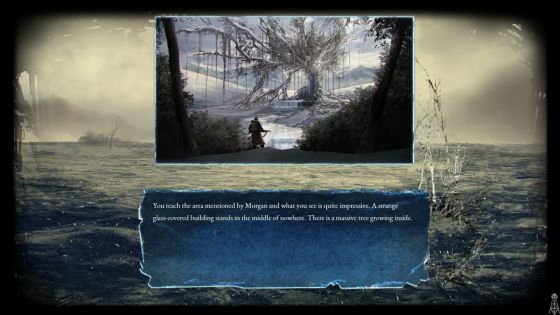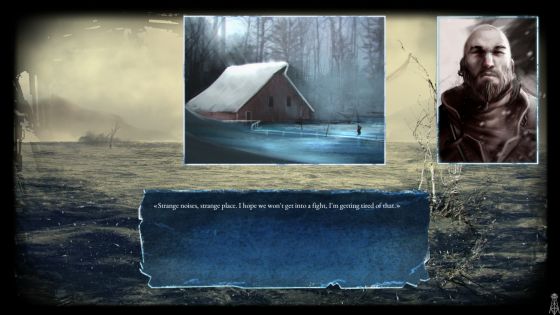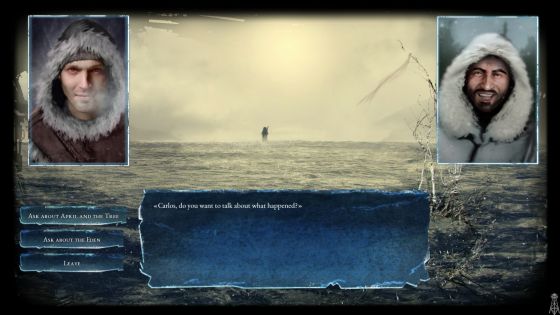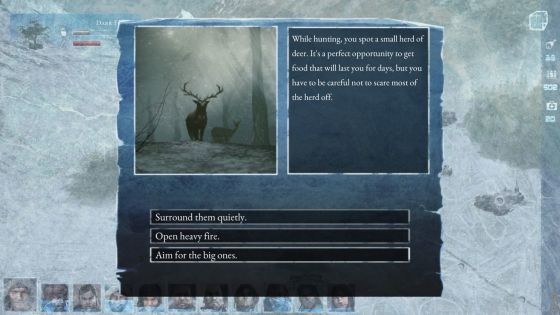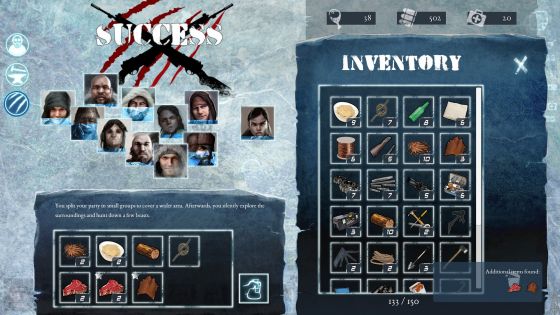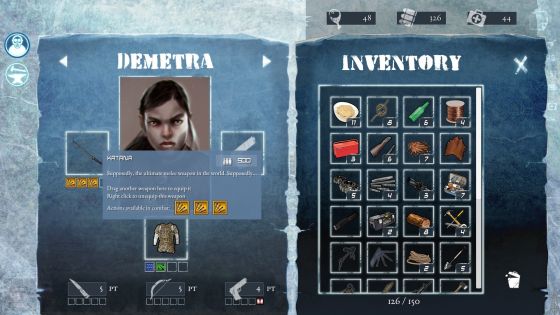ICY Review

I'm nearly out of medicine and that's not good. In the post-nuclear winter world of ICY, medicine is the only way to heal your wounded party members, and it's pretty difficult to find throughout most of the game. So I set about trying to scavenge ruins that don't seem too dangerous, because the last thing I need is to get into another fight with no way to heal up. I really hope that I find some disinfectant or bandages, as those raise up my medical supply. No such luck. I move to the next point on the map and hope I don't trigger another event, since Carlos and Mobolaji seem to be at each other's throats, and while I'd be willing to banish Carlos from the group, I'd rather not lose his wife April. Luckily, no event is triggered, but I do find a house. There is a hole in the floor, but luckily, I have a rope, which I can sacrifice to explore the hole. Inside I at least find some chemicals. With those and some cloth, I can be craft bandages. My medicine supply goes up from 8 to 9. A small victory, but a victory nonetheless. ICY is a survival-RPG, which despite its low budget manages to pull off what few other low budget RPGs do, namely being a full blown RPG, with the all the RPG elements you could wish for, but within a fairly limited scope.
Before We Begin. . .
Just so it's clear, this is a review for the Frostbite edition of ICY. It was funded on Indigogo and at some date in the past released on Steam. The game received a lukewarm reception, so the developers decided to pull it from Steam, implement changes based on the criticisms and suggestions of the initial players, and rerelease it as the Frostbite edition. I never played the initial version, nor was I a backer, so this review is, for better or worse, not influenced by the game's history. I picked the game up during the Black Friday sale on Steam.
Story and Atmosphere
ICY takes place in a cold, harsh world, presumably suffering from the aftermath of a nuclear winter. The game is set in an isolated valley, with a few fortified settlements, plenty of bandits, and the dread red riders, a sort of post-apocalyptic horde of raiders, reminiscent of the Huns or the Mongols. You start as a newer member of a scavenger family. This basically is a group that wanders the wastes, hunting and scavenging and the trading with settlements. Your family found you after an accident and you have (surprise!) lost your memories of who you were.
This tree is one of ICY's unique story locations.
ICY is a story driven game. You search for your past, revenge and kidnapped comrades. Many locations you visit unfold as story vignettes, sort of like a choose your own adventure book, but taking into account your character's skills and equipment, sort of like much more intensive and detailed versions of Pillars of Eternity's vignettes, or like some encounters from Planescape: Torment. How you decide to handle these can have consequences as minor as gaining some extra food or taking minor damage, and as major as losing a companion. In addition, the game has multiple ending depending on your choices.
Your companions will often comment on events and locations.
In ICY you, through a tragic event, become the leader of your "family." Each member who joins you is a unique character with his or her own skill set and outlook. Your companions will often comment on the outcome of quests, the discovery of new locations, or the choices you make. In general, they are well done, and you get a good sense of whom you are travelling companions are. You can also, if you wish to do that, spend extra time talking with them and discussing their pasts
You can optionally talk to companions if you wish. Let's see what Carlos thinks.
The game does a good job of depicting its freezing post-apocalyptic world. While anyone who has played Fallout or Wasteland 2 will notice similarities to ICY, they will also notice distinct differences. ICY has the feel of a "modern" world, not a retro world of the 1950s or 1980s. It also is not a world covered with a barren radiation soaked wasteland, but has snow covered ruins and dark forests. Instead of giant roaches and scorpions, you will encounter roaming wolf packs and mammoths. In addition, ICY's mutants more resemble mountainous Yeti than say the Incredible Hulk.
ICY's writing, story, companions and atmosphere are well done, well enough so that they carry the game. On the other hand, ICY offers nothing that we have not seen in other games. Nor is there any surprising plot twists like one experiences in the best-written role-playing games.
Exploration and Survival
Nodes often have a variety of locations. The ones here are especially dangerous. In the forests I can hunt, in the cave I can scavenge.
Though writing and quests are an important part of ICY, you can pretty much travel around the game's world more or less at will, with only a few individual locations shut off until you get the correct quest. ICY's world is divided into a number of nodes. Each time you travel to a new location, you open up new paths to neighboring locations on the map. Some locations, such as a town open up another map, or possible quests. Most locations though offer the chance to scour ruins or to hunt in forests. Each ruin or woods have two bars. A white bar indicates the chance of finding something useful. A red bar indicates dangers. Danger is mitigated by your main character's exploration skill, and either their hunting skill (in the woods) or scavenging skill (in ruins). Depending on your skill, you can trigger positive or negative story vignettes, which often involve gaining extra loot, or taking damage. These in turn can often be mitigated by having a particular skill, or having a piece of equipment, you can sacrifice, such as a rope, a lock pick, or a torch.
My hunting had yielded a random encounter. Success at any of these three approaches will be dependent on my skills.
You need what you find in ICY for two reasons. First is you have two resources: food and medicine. Food is consumed when you move to a new mode. You will need medicine to heal up after a battle or dangerous event. Running out of either one is pretty bad. Your group also starts (which makes sense in context of the story) losing almost all of their equipment. Therefore, you will need to find replacements. At first, you will find makeshift items and later you can afford better equipment buy selling what you find.
My successful skill check yields extra meat and leather. (shown by the silver stars.)
ICY also has an effective but not overly complicated crafting system. Normally you can create an item by combining two others. For example, cloth and animal fat can be used to make a torch. You start out with a number of crafting recipes, but others can be bought in the various towns in ICY.
The exploration-crafting-equipment system works well in ICY. It motivates you to explore the game's relatively small world. It also gives you a sense of progression and need. The game really conveys the sense of being a hunter-scavenger and that adds to the game's atmosphere.
Combat
Unlike many RPGs, combat is not the focus of ICY. You can choose aggressive solutions, which will often result in combat, but you can often just as easily avoid combat, providing you have the right skills. Combat is always risky, because you usually take some damage in combat and repairing that uses your valuable medical supplies. On the other hand avoiding combat does not always mean you will escape damage either. In the end I felt ICY encourages to play to whatever skills you have invested in (i.e. to play your character) and I think that is a good thing.
ICY's combat is card based. I actually think this a good solution for the game. It avoids two traps that budget RPG systems can fall into. One is developing a boring combat system, which drags the enjoyment of the game down. The other is developing a good combat system at the cost of other systems and ending up with a game that is 95% combat. That is fine in a dungeon crawler, but not in a game like ICY.
In ICY there are about 10 distinct cards which are based on what equipment your characters are equipped with and what skills they have. Depending on the level of the skill or the quality of the equipment, each card can be bronze (the worst), silver, or gold (the best). In combat you can play cards either individually or in combinations of up to 3 cards. Combinations can be the same cards (3 bullets suppresses enemy fire, for example) or a mixture (stealth, aim, and bow yield a silent attack). This results in a fairly decent number of combat possibilities, dependent on what cards you draw.
First I buff my characters with unseen. . .
In addition to the normal cards, there are blank cards. You get a blank card in your deck if you are using shoddy equipment. In addition, if a character is wielding a weapon and has less than the maximum skill of 5, you get one blank card for every point lower than 5 that character's skill is. So a character with a bow skill of 2 wielding (3 blank cards) a shoddy bow (1 blank card) mixes 4 blank cards into the deck.
This means that at low levels you will often draw 50% blank cards, which limits your possibilities, whereas at higher levels you'll be able to use almost every card in your hand. Once you have emptied your hand of cards, the round ends and the opponent draws and plays their hand out.
. . . Then its time to do some damage.
The card based combat is well done for a number of reasons. First combat does not take overly long. Second, there is a definite progression in the game, where you are continuously getting more and better cards in your hand, so you get more combinations as the game advances. By the time you master the card game, ICY is also more or less over. If ICY was a longer game, I am sure the combat would get tedious, but for the game's short length, I believe the card game was the correct decision, and gave the developers valuable resources for the game's presentation and other systems.
Mechanics
ICY is a role-playing game with a skill point system similar to Fallout and many other post-apocalyptic RPGs. There are 3 different weapon skills and 6 different non-combat skills. 3 of these non-combat skills (exploration, stealth, and speechcraft) also give you cards which can be used in combat (like intimidate). The other 3 are essential for gaining food and loot, so there is in general a fairly nice balance to the skills. Level 1 in a skill costs 1 point, level 5 costs 5 points, so you can either choose to be fairly decent in all skills, or be really good in a few. There is a nice tradeoff here, in that in the story and visual novel episodes it is better to be good in many skills, but in combat it is better to have fewer gold cards than it is to have many silver and bronze ones. Your main character's skills are the only ones, which are used in the story segments. Companions, however, contribute skill based cards to combat. This really does mean your character's build is meaningful for the story segments of ICY.
Each character has one weapon slot and one armour slot, and you can decide what armour and weapon you would like on each companion.
The system is fairly basic, but there are no junk skills, and at least for firearms and melee weapons there is a meaningful equipment choice (blade vs. blunt or pistol vs. rifle). Again, for a larger longer game where combat is a game's central pillar, this system would be disappointing, but it works well in the limited scope of ICY.
Presentation
For a game in its price range and its budget, ICY has a very nice presentation. The character portraits are beautifully done, as is the game's map, and even the event and combat illustrations. The combat screen and the U.I. are sleek. The same can be said about all of the game's art assets. The sound and music are also decently done. The only thing it does not have is voice acting. All in all though for a modern indie RPG, I'd say the presentation is pretty impressive.
Summary
Though it is probably already apparent, I will now say that the Frostbite edition of ICY pleasantly surprised me. It's one of the few budget indie CRPGs you'll find, because trying to create a game with meaningful exploration, a good combat system, a well written story with consequences, and interesting companions is an overwhelming undertaking. It's also a text book example of how to meaningfully do it within a very limited budget. Each of ICY's systems is well designed for its playing time (it took me 9 hours to complete). Nothing is too complicated, but everything is well thought out and executed. However, in the end, ICY does not excel in any area, nor does it do anything particularly memorable. Still if you are looking for a good, short, cheap CRPG for in between, I can definitely recommend ICY.
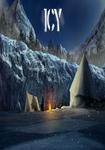
Information about
ICYDeveloper: Inner Void Interactive
SP/MP: Single-player
Setting: Post-Apoc
Genre: RPG
Combat: Turn-based
Play-time: 10-20 hours
Voice-acting: None
Regions & platforms
Internet
· Homepage
· Platform: PC
· Released: 2015-07-27
· Publisher: Digital Tribe Games
More information
Summary
Pros
- Detailed companions
- Interesting setting
- A good mix of story, exploration, survival, and combat
- Nice artwork for a low budget game
Cons
- Short playing time (9 hours)
- Relatively simple mechanics
- Excels in no area.


